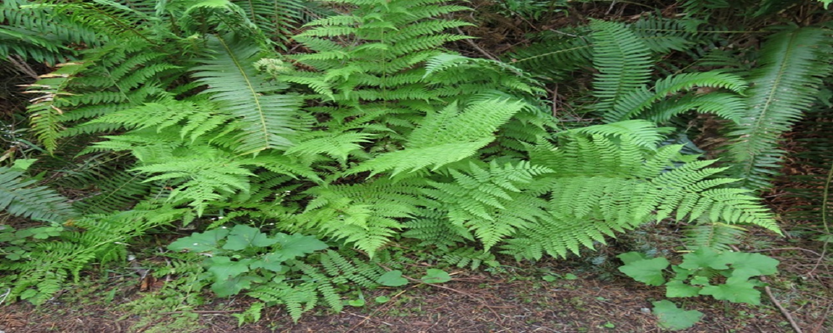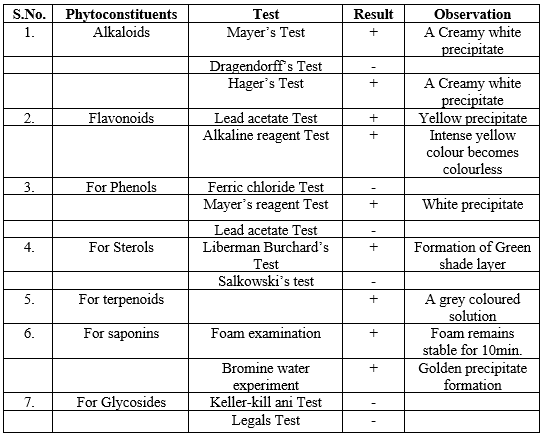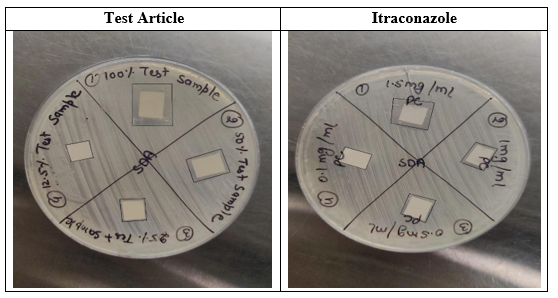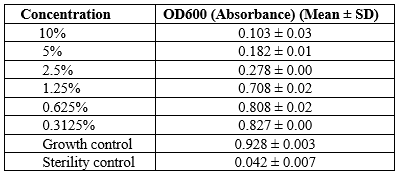Pteridium aquilinum, often called "Bracken ferns", can be eaten as a vegetable. Eating the sprouts can treat cancer, while decoction of the plant can be used to treat tuberculosis. The leaves and a poultice made from the leaves are used to treat pain and bind broken bones. Its leaves are used in baths to treat arthritis1. Bracken is a complex genus with many species, subspecies and varieties2. Preliminary research has shown that hibiscus plant contains flavonoids, phenols, terpenes, saponins, polysaccharides, etc. It shows that it has many bioactive chemical components3. P. aquilinum is rich in bioactive compounds and has many benefits such as immunomodulatory, anticancer, antibacterial, anti-inflammatory, antioxidant and antifungal properties4. Antifungal study will evaluate various parameters to assess the effect of test article “Herbal Extract of Bracken Fern” on the test strain “Candida albicans”.
Antidiuretic, Ailanthus Excelsa, Furosemide, ADH
Plants are the main source of medicine and nutrition and play an important role in protecting human health. The importance of plants in medicine is gaining more importance in today's world where medicines are obtained from plants, therefore attention is paid to the medicinal values ??of plants in terms of safety, performance and economy. The medicinal value of this plant lies in the fact that some drugs have certain physiological effects on the human body. This plant is a source of bioactive molecules that act as antioxidants and antibiotics. Fern aquilinum Kuhn. it belongs to the Polypodidae family and grows wild in Assam. It has many traditional uses, from magic to folk medicine to nutritional supplements. The leaves of the plant are used externally as an antiseptic and as an additional herb in alcoholic preparations, and the leaves of the plant are used as a vegetable by some villagers in Assam4.

Picture of Pteridium Aquilinum (Bracken Fern)
MATERIALS AND METHODS
Collection of ferns
Fresh whole plant of was collected from the various local areas of chailchowk mandi
(H.P) in February 2024. The sample was authenticated by Vallabh Government
College, Mandi in the department of botany5.
Preparation of fern extract: -
Collected fern Pteridium aquilinum was washed with running tap water and shade
dried for 2-3 weeks. Whole plant was powdered in a domestic grinder and stored in
air tight container. Known weight of crushed fern material was extracted in a Soxhlet
apparatus using methanol as a solvent. Plant extract was redistilled and dried in a
desiccator for further use6.
Phytochemicals analysis:- The extract was subjected to phytochemical screening to test the presence of metabolites such as alkaloids, phenols, glycosides, flavonoids, tannins, steroids, saponins, terpenoids7.
Test for alkaloids
(a)Dragendorff’s test: - 1mL of extract was taken and placed into a test tube. Then 1mL of potassium bismuth iodide solution (Dragendorff’s reagent) was added and shaken. An orange red precipitate formed indicates the presence of alkaloids.
(b) Mayer’s test: -1mL of extract was taken and placed into a test tube. Then 1mL of potassium mercuric iodide solution (Mayer’s reagent) was added and shaken. Emergence of whitish or cream precipitate implies the presence of alkaloids.
(c) Hager’s test:- Few ml of plant extract was taken and placed into a test tube. Then add 1-2ml of Hager’s reagent in it. Creamy white colour shows the presence of alkaloids.
Test for flavonoids
(a) Lead acetate test: - To detect the presence of flavonoids, 1mL of extract was taken and placed into a test tube. Then few drops of lead acetate added and shaken. Formation of yellow precipitate signifies the presence of flavonoids.
(b) Alkaline reagent test: - 1mL of extract was taken and placed into a test tube. Then few drops of sodium hydroxide solution were added and shaken. Emergence of intense yellow colour that turns to colourless after adding dilute acid implies the existence of flavonoids.
Test for phenols
(a) Ferric chloride test: -1mL solution of an extract was taken and placed into a test tube. Then 1% gelatine solution containing sodium chloride was added and shaken. Formation of bluish-black colour indicates the presence of phenols.
(b) Lead acetate test: - 1mL solution of an extract was taken and placed into a test tube. Then 1mL of alcoholic solution was added, followed by dilution with 20% sulfuric acid. Finally, solution of sodium hydroxide was added. Formation of red-to-blue colour signifies the occurrence of phenols.
(c) Mayer’s reagent test (potassium mercuric iodide test): -To a solution of plant extract, 1mL of Mayer’s reagent was added in an acidic solution. Manifestation of white precipitate shows the existence of phenolic compounds.
Test for sterols: -
(a) Liberman Burchard’s test: - This method is utilized for an alcoholic extract. Extract needs to dry out first through evaporation, then extracted again with chloroform. Add few drops of acetic anhydrites followed by sulfuric acid from the side of the test tube. Formation of violet to blue-coloured ring at the junction of the two liquids indicated the presence of steroids.
(b) Salkowski’s test: -1mL solution of the extract was taken and 2mL of chloroform was added, shaken, and filtered. Few drops of concentrated sulfuric acid were added to filtrate, shaken, and allowed to stand. Development of golden-yellow precipitate indicates the presence of triterpenes.
Test for terpenoids: -
(a)5ml of plant extract and 2ml of chloroform was evaporated on water bath. Then add 3ml of conc. Sulfuric acid (boiled on water bath).
Test for saponins: -
(a)Foam examination test: - In 1ml of plant extract added 2-3ml of water, on strongly shaking foam formation occurs.
(b)Bromine water experiment: - In 2ml of methanolic extract in it add some bromine water drop.
Test for glycosides: -
(a) Legals test: -1mL of an extract was taken, and then an equal volume of sodium nitroprusside was added followed by few quantities of sodium hydroxide solution and shaken. Formation of pink-to-blood-red precipitate signifies the existence of cardiac glycoside.
(b) Keller–Killian test: - 2mL of the extract was taken and diluted with equal volume of water. Then 0.5mL of lead acetate was added, shaken, and filtered. Again, the mixture was extracted with equal volume of chloroform, evaporated, and dissolved the residue in glacial acetic acid. Then few drops of ferric chloride were added. Again, the whole mixture was placed into a test tube containing 2mL of sulfuric acid. Emergence of reddish brown layer that turns bluish green implies the presence of digitoxose8.
Test procedure for Antifungal evaluation for Pteridium Aquilinum: -
Preparation of test strain: - Test strain “Candida albicans” (ATCC 1452, Hi Media, Lot no. 701-19-7) was sub cultured in the Nutrient Broth (Hi Media, Cat. No. M002-500G, Lot-0000516896), supplemented with the 24hrs at 32.5 °C, 200 rpm. The test strain “Candida albicans,” was adjusted to the concentration of the test strain equivalent to 0.5 MacFarland standard which is 2 X 105 cells/ml.
? Antifungal Activity (Disc Diffusion Assay)
(i) Different concentrations i.e. 100%, 50%, 25% and 12.5% of test article “Herbal Extract of Bracken Fern” were prepared in PBS.
(ii) Petri plates of Sabouraud Dextrose Agar (SDA) were cultured with the test strain “Candida albicans” and impregnated with sterile Whatman’s filter paper with different concentrations i.e. 100%, 50%, 25% and 12.5% of test article “Herbal Extract of Bracken Fern”. 2mg/ml, 1.5mg/ml, 1mg/ml, 0.5mg/ml of Itraconazole were used as positive controls and incubated for 24hrs at 37°C in BOD incubator6.
? Minimum Inhibitory Concentration (MIC)
(i)Different dilutions (10%, 5%, 2.5%, 1.25%, 0.625% and 0.3125%) of test article “Herbal Extract of Bracken Fern” was prepared with Mueller Hinton broth.
(ii) 5x105 cells/ml of the test strain “Candida albicans” in Mueller Hinton Broth and Supplemented Nutrient Broth were used as growth control and sterility control for the test. o Dilutions (10%, 5%, 2.5%, 1.25%, 0.625% and 0.3125%) of test article “Herbal Extract of Bracken Fern” were added to the test strain “Candida albicans” in 1:1 ratio and incubated at 37 °C in BOD incubator at 200 rpm for 24hrs. Absorbance was observed at 600nm.
RESULT AND DISCUSSION
Preliminary phytochemical screening: - The presence and absence of constituents were indicated by using the following symbols: For presence of constituents (+) and for absence of constituents (-). The plant powdered sample was chemically screened for alkaloids, phenols, tannins, flavonoids, sterols and terpenoids, saponins, cardiac glycosides9.

Table1-Result of phytochemical screening of extract of Pteridium aquilinum plant (Bracken Fern)
Result of Antifungal activity by disc diffusion assay: -

Table 2: - Comparison of area of zone of inhibition of different concentrations of test article “Herbal Extract from Bracken Fern” and “Itraconazole

Table 3: - Images for zone of inhibition different dilutions of concentrations of test article “Herbal Extract from Bracken Fern” and “Itraconazole”
Minimum Inhibitory Concentration (MIC)

Table 4: Absorbance values at 600nm
CONCLUSION
Ferns are not economically important but have a considerably importance in medicine and food10. Bracken fern is the most distributed common weed species in the world11. In conclusion, plant of Pteridium aquilinum exhibited certain important phytochemicals and any other activities4. The phytochemical analysis is very much important to evaluate the possible medicinal utilities of a plant and also to determine the active principles responsible for the known biological activities exhibited by the plants. Further, it provides the base for targeted isolation of compounds and to perform more precise investigations. Extraction of a phytochemical from the plant material is mainly dependent on the type of solvent used. Similarly, the test applied for phytochemical analysis determines the presence or absence of a phytochemical in the sample. Hence, two or more different tests should be performed for more accurate results12. The phytochemical characters of the samples are summarized in Table1. Presence of alkaloids, saponins, flavonoids, phenols, sterols, and terpenoids and absence of cardiac glycosides were recorded in the sample4. These phytochemicals are playing vital role for the treatment of various types of disease therefore they are still used in the modern and traditional system of medicine10. Study data suggests the antifungal activity of the test article “Herbal Extract of Bracken Fern” is increased in the concentration dependent manner as compared to the different concentrations of positive control “Intraconazole” It also suggests the inhibition of the test strain “Candida albicans” is at a concentration of 2.5% due to its antifungal property. Growth control showed proper growth, so the study done is valid and the absence of any contamination or microbial growth proves the sterility maintained during the test study.
REFERENCES


 Shivani Sharma*
Shivani Sharma*





 10.5281/zenodo.11410472
10.5281/zenodo.11410472